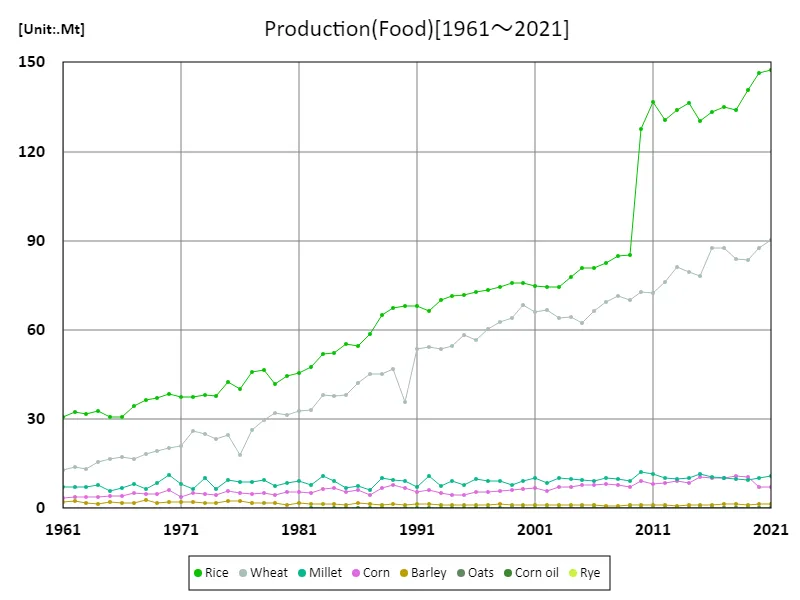Abstract
India’s grain production is mainly focused on key crops such as rice, wheat and maize. Data for 2022 shows that rice production is the largest at 196 million tonnes (Mt), making India the leading rice producing country globally. Wheat and corn are also important crops, but rice production stands out. Domestic consumption of food grains accounts for a large proportion of the country’s food supply, particularly rice and wheat. Meanwhile, exports of grains are also on the rise, with India being a major exporter, especially of rice. In 2022, export volumes are expected to increase, with demand especially to Southeast Asia and Africa. When it comes to animal feed, corn and soybeans play an important role, producing the grains necessary for livestock farming. Overall, Indian grain production caters to the domestic demand and also plays a significant role in the export market.
Production(production (production volume))
India’s grain production has grown significantly between 1961 and 2022. Rice production was particularly notable, reaching a peak of 196 million tonnes (Mt) in 2022, achieving 100% of the previous record. This growth is due to advances in agricultural technology, the expansion of irrigation facilities, and government support measures. Rice is India’s major crop, accounting for a large portion of domestic consumption and also playing a significant role in exports. From the 1960s to the 1970s, growth in production was slow, but the ”Green Revolution” that began in the 1980s led to the spread of high-yielding varieties and technological innovation, resulting in a rapid increase in production. Since then, production has continued to increase steadily, and even in the face of climate change and water resource issues in recent years, rice production has remained stable. India also occupies an important position as a global supplier of rice, and will continue to require stable production in the future.


The maximum is the latest one, 196Mt of Rice
Production (food)
India’s food-grade cereal production has increased steadily between 1961 and 2021. Rice production is particularly important, reaching a record high of 147 million tonnes (Mt) in 2021. Rice is India’s staple food and accounts for the majority of domestic consumption, with food production reaching 100% of its peak. This increase has been made possible by improved agricultural techniques, government support, and improved irrigation facilities. From the 1960s to the 1970s, the increase in production was slow, but since the 1980s, the ”Green Revolution” has led to the spread of high-yielding varieties and improvements in agricultural techniques, resulting in a rapid increase in food grain production. Rice production is particularly notable, with production volumes increasing steadily in line with rising domestic consumption. In recent years, in order to meet the increase in consumption, the strengthening of agricultural policies and the development of irrigation technology have played an important role, and the production of food grains, especially rice, continues to show steady growth.


The maximum is the latest one, 147Mt of Rice
Import and export (exports)
Based on 1963 data, India’s exports of grains were dominated by rice at 31.6 million tonnes (Mt), with total exports standing at 43.5 Mt. During this period, rice was India’s major export commodity and accounted for a large proportion of its exports. The average export volume was 7.25 million tons, and although other crops such as wheat and corn were also exported in addition to rice, the proportion of rice was particularly large. In the early 1960s, India was in a difficult position in agricultural production, and domestic supply was prioritized over exports. However, from the late 1960s onwards, technological advances in agriculture and the ”Green Revolution” led to a rapid increase in production, and the surplus began to be exported. In particular, as a result of stable rice production and increased exports, India has established itself as a major rice exporting country. Since then, grain exports, especially rice, have increased and India has become an important player in the global grain market.


The maximum is the latest one, 16.4Mt of Corn
Animal (feed)
In India, animal feed production in the cereal production is dominated by corn at 16.4 million tonnes (Mt), which is the largest production volume, based on data for 1961. Corn plays an important role as livestock feed and is in high demand, especially in areas where livestock rearing is widespread. During this period in India, as agricultural technology improved, the production of feed crops expanded and the demand for corn as livestock feed also increased. Animal feed production in India is closely linked to the development of livestock industry. Livestock farming is a significant industry, which has led to an increased supply of feed for the production of meat, dairy and eggs. In addition to corn, soybeans and fodder corn are also used as feed, and agricultural diversification is progressing. Especially in recent years, with the increase in food demand, the production of feed grains has been stable, and Indian agriculture is contributing to the development of the livestock industry as well as domestic consumption.


The maximum is the latest one, 16.4Mt of Corn



Comments